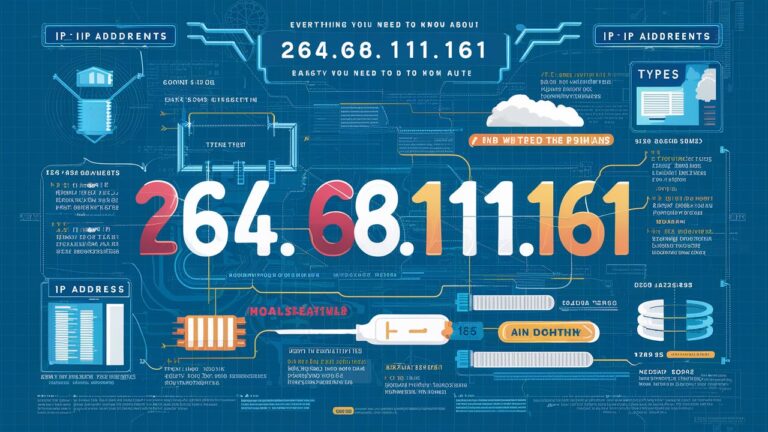In the vast and intricate landscape of the internet, IP addresses play a foundational role in connecting users to websites, servers, and digital services. One IP address that has garnered attention is 264.68.111.161. This article explores everything about this IP address, its structure, legality, possible uses, and reasons it might appear in network logs or be flagged by systems.
Understanding IP Address 264.68.111.161
An IP (Internet Protocol) address is a unique identifier assigned to devices on a network. It serves as a way to send and receive data across the internet or local networks. However, when it comes to 264.68.111.161, a critical aspect needs to be addressed: it is not a valid IPv4 address.
IPv4 addresses are composed of four numbers ranging from 0 to 255, separated by periods. The address 264.68.111.161 violates this rule, as 264 exceeds the maximum value of 255, making it invalid for standard IPv4 use.
Why Does an Invalid IP Like 264.68.111.161 Appear?
Despite being invalid, an address like 264.68.111.161 may still show up in server logs, network traffic reports, or cyber threat analysis platforms. There are a few possible explanations for this:
1. Malicious Activity or Spoofing
Attackers sometimes forge IP headers to mask their true location or deceive tracking tools. An invalid IP address can be inserted in malicious packets to confuse firewalls or intrusion detection systems. This technique is known as IP spoofing, and it is often used in DDoS attacks, botnets, or spam campaigns.
2. Typographical Errors in Configurations
Administrators or software scripts may accidentally insert invalid IPs due to human error. If a script dynamically pulls or generates IPs and lacks validation logic, 264.68.111.161 could mistakenly be logged, despite being unreachable.
3. Testing and Research Environments
In some cybersecurity research or educational tools, non-routable or invalid IP addresses like 264.68.111.161 might be deliberately used to represent hypothetical scenarios. These addresses are never routed publicly and are meant for simulation purposes only.
Security Implications of Seeing 264.68.111.161 in Logs
If 264.68.111.161 appears in your system logs or firewall reports, it should be taken seriously. Even though it’s invalid, its appearance could indicate one of several scenarios:
-
Reconnaissance by Attackers: Cybercriminals might be probing systems and testing firewall responses.
-
Attempted Exploits: Malformed IPs are often a signature of attempted buffer overflow or parser exploits targeting poorly validated software.
-
Scripted Bot Activity: Bots may use randomized or deliberately malformed IPs to evade detection.
Immediate actions may include:
-
Running a deep scan on the network for anomalies.
-
Enabling strict IP validation in firewall and intrusion prevention systems.
-
Checking logs for patterns of malformed IP access attempts.
Legal and Ethical Considerations
Using or processing malformed IP addresses like 264.68.111.161 falls into a grey area, especially when it comes to penetration testing or threat simulation. While it’s technically possible to include invalid IPs in private networks or testing labs, pushing such packets onto the public internet can violate terms of service or even local cybercrime laws.
Organizations must ensure that any simulations involving invalid IPs are contained within isolated environments and do not inadvertently impact real-world systems or networks.
How to Block or Filter Invalid IP Addresses Like 264.68.111.161
If you manage network security, you should have systems in place that detect and filter out malformed IP addresses. Here’s how to do it:
1. Configure Firewall Rules
Modern firewalls like pfSense, Cisco ASA, or FortiGate can be set to detect and drop malformed or non-routable IP traffic. Adding custom rules to automatically reject IPs outside the valid range is a crucial first step.
2. Use IDS/IPS Solutions
Intrusion Detection and Prevention Systems such as Snort or Suricata can identify and block packets containing suspicious or malformed IP headers. Set up rules that flag any source or destination IP where any octet is greater than 255.
3. Employ Log Analysis Tools
Use log analyzers like Splunk, Graylog, or ELK Stack to filter and isolate entries with invalid IPs. These tools can help correlate events and determine if further actions are needed.
Common Questions About 264.68.111.161
What is 264.68.111.161 used for?
This IP is not officially assigned or valid under IPv4 standards. If seen in network activity, it’s likely the result of spoofing, testing, or misconfiguration.
Can an IP start with 264?
No, IPv4 addresses are limited to 0-255 in each of the four octets. Anything higher is invalid and cannot be routed on the public internet.
Should I be concerned if I see 264.68.111.161?
Yes. Its presence may indicate malicious intent, testing probes, or faulty software behavior. It warrants further investigation to ensure system integrity.
Is 264.68.111.161 assigned to any country or ISP?
No. Since it’s not a valid IP, it’s not part of any assigned IP block. You won’t find a geolocation match for it on any reliable IP database.
Conclusion
While 264.68.111.161 may not be a real IP address in the conventional sense, its appearance in network environments should raise flags. Whether caused by spoofing, misconfiguration, or research activities, malformed IP addresses can indicate deeper security issues. Understanding these anomalies and responding with robust network hygiene is essential for maintaining a secure and resilient infrastructure.
Always validate your IP inputs, monitor your logs, and stay ahead of malicious actors by filtering out invalid traffic. Network security starts with awareness and continues with proactive defense strategies.
